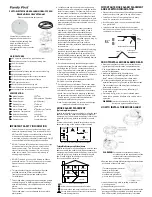
21
(4) Repeat procedure as necessary.
Over a period of three or four days of cycling it is
frequently possible to restore a significant portion of
lost performance. If cycling fails to improve
performance, the battery pack will probably need to
be replaced.
2.4
Methods of sampling
The PhD Ultra may be used as either a "Diffusion"
or "Sample-Draw"-type monitoring device.
In normal operation, the PhD Ultra detector is worn
on the belt, used with its shoulder strap, or held in
the hand. Once turned on, the PhD Ultra monitors
continuously. The atmosphere being measured
reaches the sensors by diffusing through vents in
the sensor compartment cover. Normal air
movements are enough to carry the sample to the
sensors. The sensors react quickly to changes in
the concentrations of the gases being measured.
This type of "diffusion" operation monitors only the
atmosphere that immediately surrounds the
detector.
It is possible to use the PhD Ultra to sample remote
locations by using a sample-draw kit. Two sample-
draw kits are available. In each case the gas
sample is drawn in through a probe assembly, and
travels through a length of hose back to the
instrument. One type of kit uses a hand-operated
squeeze-bulb to draw the sample through the hose
while the other uses a motorized continuous
mechanical pump that draws its power directly from
the PhD Ultra battery pack. A hand-aspirated
sample-draw kit is included as an accessory with
every PhD Ultra.
2.4.1 Using the hand aspirated sample
draw kit
(1) Connect the slip-on sample draw / calibration
adapter with the squeeze bulb and hose
assembly.
(2) Connect the end of the hose closest to the bulb
to the sample draw adapter.
(3) Connect the other end of the hose to the sample
probe as shown in
Figure 2.4.1.1.
(4) Attach the sample draw adapter to the PhD
Ultra as shown in
Figure 2.4.1.2
.
(5) Cover the end of the sample draw probe
assembly with a finger, and squeeze the
aspirator bulb. If there are no leaks in the
sample draw kit components, the bulb should
stay deflated for a few seconds.
Failure to test the sample
draw kit prior to each use may result in
inaccurate readings.
(6) Insert the end of the sample probe into the
location to be sampled.
(7) Squeeze the aspirator bulb one time for each
foot of sample hose for the sample to reach the
sensor compartment. Then continue squeezing
the bulb for an additional 45 seconds until
readings stabilize.
Failure to correctly follow the
usage instructions for the sample draw kit may
lead to inaccurate readings.
(8) Note the gas measurement readings.
Figure 2.4.1.1. PhD Ultra hand aspirated sample draw
kit
Figure 2.4.1.2. PhD Ultra with hand aspirated sample
draw kit attached
CAUTION:
Hand aspirated remote sampling
only provides continuous gas readings for the
area in which the probe is located when the bulb
is being continuously squeezed.
Each time a reading is desired, it is necessary to
squeeze the bulb a sufficient number of times to
bring a fresh sample to the sensor compartment and
to continue squeezing for another 45 seconds or
until readings stabilize. If continuous remote
sampling is required, a battery operated, continuous,
mechanical sample-draw pump should be used.
2.4.2 Continuous (slip-on) sample draw
pump
Use of the slip-on sample draw pump allows the
PhD Ultra to continuously monitor remote locations.
The pump is powered directly by the PhD Ultra
battery. A flashing “P” indicator in the upper left
corner of the LCD display indicates that the pump is
attached and in normal operation.
















































